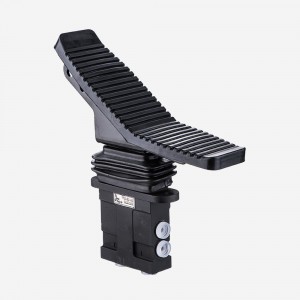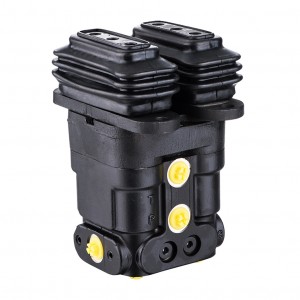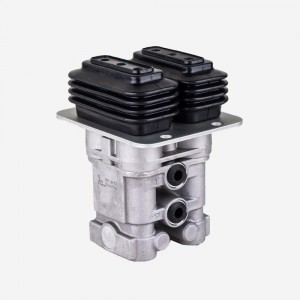
Excavator operators often struggle with slow movement and mechanical issues. These challenges can reduce productivity and increase frustration. Hydraulic foot valves solve these problems by improving walking control. They allow precise, smooth movements, ensuring better performance on-site. With their durable design, these valves handle tough conditions while maintaining reliability. Safety features, like locking mechanisms, prevent accidents during operation. Choosing the right components matters. For example, sourcing from a top hydraulic pilot control valve supplier ensures high-quality performance and long-term efficiency.
Key Takeaways
- Hydraulic foot valves help excavators move smoothly and accurately, making work easier.
- Buying good parts from trusted brands makes machines work better and last longer.
- Cleaning and checking hydraulic foot valves often keeps them working well for a long time.
- Safety locks on hydraulic foot valves keep operators safe and build trust while using them.
- Make sure the valves fit your excavator brand to avoid problems and damage.
Understanding Excavator Walking Issues
Common Problems Faced by Operators
When I think about excavator walking issues, I immediately recall the challenges operators face daily. One of the most common problems is hydraulic motor failures. These failures often occur when the hydraulic motor reducer malfunctions, leading to excessive load and pressure in the hydraulic circuit. This can cause the engine to choke, making operations frustrating and inefficient.
Another issue I’ve noticed is traveling card problems. These happen when the pilot valve stem isn’t positioned correctly. Without stable pressure in the pilot system, the excavator struggles to move smoothly. This instability can make even simple tasks feel like a battle.
Walking frustration is another frequent complaint. Unstable variable control of the main pump disrupts the flow and displacement adjustments. This makes it difficult to maintain consistent movement, leaving operators feeling stuck. Lastly, slow walking speed is a significant concern. Failures in the high-low speed conversion system can trap the excavator in low-speed mode, drastically reducing its mobility.
Impact on Performance and Productivity
These walking issues don’t just frustrate operators; they also hurt productivity. When an excavator moves slowly or inconsistently, it delays project timelines. For example, slow walking speed can prevent operators from completing tasks on schedule. This impacts the overall efficiency of the job site.
Hydraulic motor failures and traveling card problems also increase downtime. Repairs take time and resources, which could have been used for productive work. Additionally, walking frustration caused by unstable control systems can lead to operator fatigue. When operators are tired, their focus and efficiency drop, further reducing productivity.
To address these challenges, I always recommend investing in high-quality components. Choosing parts from a top hydraulic pilot control valve supplier ensures better performance and reliability. This simple step can significantly improve the walking control of excavators, boosting both efficiency and operator satisfaction.
How Hydraulic Foot Valves Work

Functionality and Operation
When I think about the functionality of hydraulic foot valves, I see them as the bridge between the operator and the excavator’s walking system. These valves convert the physical force applied by the operator’s foot into hydraulic energy. This energy then powers the excavator’s movement. The process feels seamless, but it relies on precise engineering.
The operation is straightforward. The foot valve connects to the hydraulic system of the excavator. When the operator presses the pedal, the valve opens, allowing hydraulic fluid to flow. This fluid activates the motors responsible for the machine’s forward or backward movement. Releasing the pedal closes the valve, stopping the flow and halting the excavator. This simple mechanism ensures smooth and controlled operation.
I find the design of these valves impressive. They are built to handle high pressure and extreme conditions. For example, the Hydraulic Foot Valve for Excavator Walking from Ningbo Flag Hydraulic Co., Ltd. operates efficiently even in temperatures ranging from -20°C to 90°C. This durability ensures reliable performance in various environments.
Role in Regulating Hydraulic Flow
The hydraulic foot valve plays a critical role in controlling the flow of hydraulic fluid. It acts as a gatekeeper, managing the amount of fluid that reaches the motors. This regulation determines the speed and direction of the excavator’s movement. I’ve noticed that precise flow control is essential for maintaining stability during operation.
One feature I appreciate is the valve’s ability to provide consistent pressure. This consistency ensures that the excavator moves smoothly, even under heavy loads. The valve also prevents sudden changes in speed, which could destabilize the machine. By maintaining a stable flow, the hydraulic foot valve enhances both safety and efficiency.
In my experience, the quality of the valve significantly impacts its performance. High-quality valves, like those from Ningbo Flag Hydraulic Co., Ltd., offer exceptional sealing and durability. This ensures that the hydraulic system remains free from leaks and contaminants, further improving the excavator’s reliability.
Features and Benefits of Hydraulic Foot Valves

Accurate Control and Stability
I’ve always believed that precise control is the foundation of efficient excavator operation. Hydraulic foot valves excel in this area by providing unmatched accuracy and stability. These valves regulate hydraulic flow with precision, ensuring smooth and consistent movement. This stability is especially important when working on uneven terrain or handling heavy loads. Operators can rely on the valve to maintain balance and control, even in challenging conditions.
To ensure this level of performance, manufacturers subject hydraulic foot valves to rigorous testing. For example, I’ve seen how performance tests evaluate flow characteristics like flow rate and pressure drop. These tests confirm that the valve meets its specifications. Here’s a quick overview of the testing procedures:
| Testing Procedure | Description |
|---|---|
| Visual Inspection | Examination of the valve body, bonnet, stem, and actuator for damage, wear, or corrosion. |
| Pressure Testing | Verifies the valve’s ability to withstand pressure, detecting leaks by applying pressure at 1.5x max operating pressure. |
| Functional Testing | Evaluates the valve’s response time, control signal, and shutoff capability to ensure proper operation. |
| Performance Testing | Assesses flow characteristics like flow rate and pressure drop, comparing results to specifications. |
| High-Pressure Testing | Confirms the valve can withstand specified high pressure without leaking. |
These tests guarantee that the valve delivers the control and stability operators need on the job site.
High Reliability and Durability
Durability is another standout feature of hydraulic foot valves. I’ve noticed that these components are built to withstand extreme conditions, from high-pressure environments to temperature ranges as wide as -20°C to 90°C. This robust construction ensures long-term reliability, even under heavy use. For instance, the Hydraulic Foot Valve for Excavator Walking from Ningbo Flag Hydraulic Co., Ltd. is engineered with premium materials and advanced manufacturing techniques. This makes it a dependable choice for operators who demand high performance.
Choosing components from a top hydraulic pilot control valve supplier ensures you get products that meet the highest quality standards. These suppliers focus on rigorous quality control, ensuring that every valve performs reliably over time.
Enhanced Safety Features
Safety is always a priority in excavator operations. Hydraulic foot valves come equipped with features like locking mechanisms and safety switches. These additions prevent accidental activation, reducing the risk of operator injury. I’ve found that this focus on safety not only protects operators but also boosts their confidence during operation. When you know your equipment is designed with safety in mind, you can focus entirely on the task at hand.
By sourcing from a top hydraulic pilot control valve supplier, you can ensure that your valves include these essential safety features. This investment in safety and reliability pays off in the long run, enhancing both productivity and peace of mind.
Applications and Compatibility
Suitable Excavator Types and Scenarios
I’ve seen hydraulic foot valves excel in a variety of applications. These components are not limited to excavators alone. They also play a vital role in other hydraulic systems. Here are some common scenarios where hydraulic foot valves shine:
- Hydraulic tools: They control the movement of cutting and drilling machines, ensuring precision and efficiency.
- Hydraulic machinery: They regulate movements in shearing and punching machines, which require stable and accurate control.
- Automotive maintenance: They operate jacks and hydraulic lifting platforms, making vehicle maintenance safer and more efficient.
- Industrial machinery: They manage hydraulic actions in clamping devices and presses, ensuring smooth operation.
For excavators, hydraulic foot valves are particularly effective in heavy-duty tasks like digging, grading, and material handling. Their ability to provide precise control makes them indispensable in construction, mining, and landscaping projects.
Compatibility with Popular Brands
When selecting a hydraulic foot valve, I always emphasize the importance of compatibility. Matching the valve with the excavator model ensures optimal performance. For example, the Hydraulic Foot Valve for Excavator Walking from Ningbo Flag Hydraulic Co., Ltd. is compatible with popular brands like Sany, XCMG, LGMG, and Carter. This versatility makes it a reliable choice for operators working with different machines.
To ensure compatibility, I recommend checking the manufacturer’s specifications. Details like size, pressure capacity, and flow rate are crucial. The valve must handle the maximum pressure generated by the excavator and allow sufficient hydraulic fluid flow. This prevents inefficiencies or potential damage to the system. Proper compatibility guarantees smooth operation and extends the lifespan of both the valve and the excavator.
Why Choose a Top Hydraulic Pilot Control Valve Supplier
Choosing the right supplier is just as important as selecting the right valve. I always advise working with a top hydraulic pilot control valve supplier. These suppliers prioritize quality and reliability. For instance, Ningbo Flag Hydraulic Co., Ltd. has over 15 years of experience in the industry. Their commitment to innovative design and lean manufacturing ensures that their products meet the highest standards.
A reputable supplier also provides excellent customer support. They help operators select the right valve for their specific needs. This guidance minimizes the risk of compatibility issues and ensures optimal performance. By partnering with a trusted supplier, you can enhance your excavator’s functionality and efficiency while reducing downtime.
Installation and Maintenance Tips
Installation Guidelines
Installing a hydraulic foot valve requires careful attention to detail. I always follow a systematic approach to ensure proper functionality and safety. Here are the steps I recommend:
- Inspect the Valve and Components: Before installation, I check the valve for any visible damage or defects. This includes inspecting the body, seals, and connectors.
- Prepare the Hydraulic System: I clean the hydraulic lines to remove contaminants. This prevents debris from entering the valve and affecting its performance.
- Follow Manufacturer Standards: Standards like API 6D, ASME B16.34, and MSS SP-67 provide essential guidelines for valve installation. These standards ensure the valve operates efficiently under pressure and temperature variations.
- Position the Valve Correctly: I align the valve with the hydraulic system, ensuring the flow direction matches the markings on the valve.
- Secure Connections: Tightening the fittings properly is crucial. Loose connections can lead to leaks, while overtightening may damage the valve.
- Test the System: After installation, I run a pressure test to verify the valve’s performance. This step ensures there are no leaks and the valve operates smoothly.
| Standard | Description |
|---|---|
| API 6D | Covers the design and manufacture of pipeline and pipeline valve components. |
| ASME B16.34 | Provides guidelines for valve pressure-temperature ratings and materials. |
| MSS SP-67 | Covers the design of control valves, including materials and actuator design. |
Maintenance Best Practices
Regular maintenance keeps hydraulic foot valves in top condition. I’ve found that a proactive approach minimizes downtime and extends the valve’s lifespan. Here’s what I do:
- Clean the Valve Regularly: Dirt and debris can accumulate over time. I clean the valve and surrounding components to maintain optimal performance.
- Inspect for Wear and Tear: I check the seals, connectors, and moving parts for signs of wear. Replacing worn components promptly prevents further damage.
- Monitor Hydraulic Fluid Quality: Contaminated fluid can harm the valve. I ensure the fluid meets cleanliness standards, such as NAS level 9 or below.
- Lubricate Moving Parts: Proper lubrication reduces friction and prevents premature wear. I use manufacturer-recommended lubricants for the best results.
- Schedule Routine Checks: I follow a maintenance schedule based on the valve’s usage and operating conditions. This includes pressure testing and performance evaluations.
By following these practices, I ensure the hydraulic foot valve operates reliably. Choosing components from a top hydraulic pilot control valve supplier also simplifies maintenance. High-quality valves are easier to maintain and offer better durability, reducing the need for frequent repairs.
Hydraulic foot valves have transformed how I approach excavator walking control. These components provide unmatched efficiency, reliability, and safety. They simplify operations, making even the most challenging tasks manageable.
Post time: Apr-09-2025
